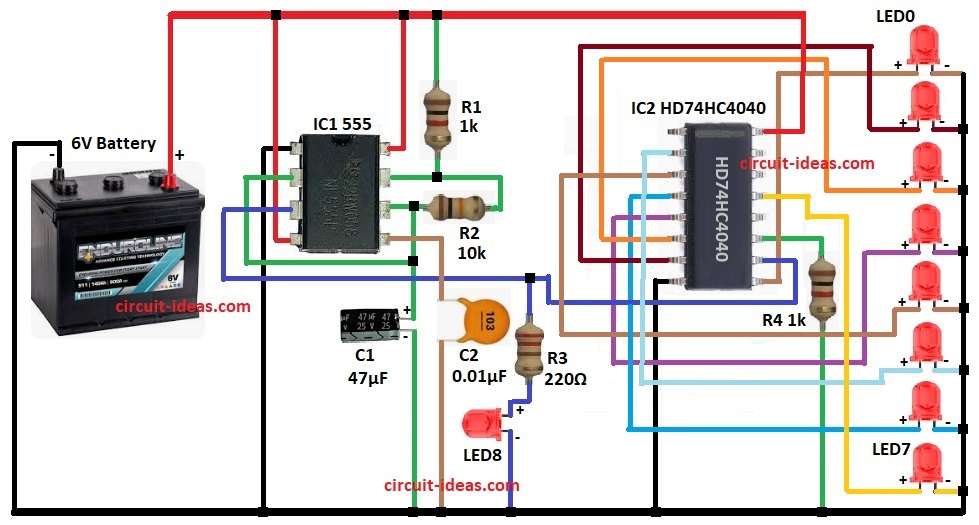This project is for LED Binary Counter Circuit
It uses IC 555 timer as clock pulse generator.
And it uses 74HC4040 binary counter IC.
LEDs are connected to output which show binary count.
It works from 6V battery or DC supply.
Circuit Working:

Parts List:
| Component | Value | Quantity |
|---|---|---|
| Resistors | 1k | 2 |
| 10k | 1 | |
| 220Ω | 1 | |
| Capacitors | Electrolytic 47µF 25V | 1 |
| Ceramic 0.01µF | 1 | |
| Semiconductors | IC 555 Timer | 1 |
| IC HD74HC4040 Binary Counter | 1 | |
| LEDs 5mm 20mA any color | 9 | |
| Battery 6V DC Supply | 1 |
The circuit uses a 6V battery or regulated DC supply.
IC1 555 is in astable mode, generating continuous clock pulses.
R1, R2 and C1 set the pulse frequency.
Each pulse goes to the clock input of IC2 74HC4040.
IC2 is a 12-stage binary ripple counter.
Each pulse increments the binary count.
Outputs Q0 to Q7 light up LEDs.
LEDs display the binary value.
C2 filters noise in the circuit.
R3 limits current to the LEDs.
R4 connects to the reset pin (MR).
When MR is high then the counter resets to zero.
Formulas:
Formula for 555 Astable Frequency:
f = 1.44 / ((R1 + 2R2) × C1)
here,
- f is the output frequency of the 555 timer (Hz)
- R1 and R2 are the resistors controlling timing
- C1 is the capacitor controlling timing
How to Build:
To build a LED Binary Counter Circuit follow the below steps for connections:
- Take all the components as shown in circuit diagram
Connection of IC1 555:
- IC 555 pin 1 to ground.
- Pin 2 and pin 6 shorted.
- Pin 3 is output clock pin connected to pin 10 of IC2
- Pin 4 reset go to +6V.
- Pin 7 DC pin goes between resistors R1 and R2.
- Pin 8 Vcc pin go to +6V.
- Pin 2 of IC1connects to junction of R2 and C1.
- Pin 5 connected to capacitor C2 to ground.
Connections of IC2 74HC4040:
- Outputs pins of IC2 are pins 9, 7, 6, 5, 3, 2, 4, 13.
- Each output pins are connected to anode of LED1 to LED8
- LEDs cathode go to ground.
- Pin 8 go to ground.
- Pin 10 is clock input from IC 555 output with resistor R3 and LED9
- Pin 11 MR reset pin connected with resistor R4 to ground.
Connection of battery 6V:
- 6V battery positive side connects to the positive terminal of the cicuit.
- 6V battery negative side connects to the GND of the circuit
Conclusion:
This LED Binary Counter Circuit is simple to make.
IC1 555 makes clock pulses.
IC2 74HC4040 counts pulses.
LEDs show binary numbers.
Circuit is useful for students and beginners.
It teaches binary counting and digital IC use.
Leave a Reply